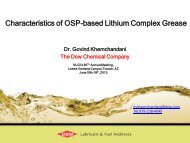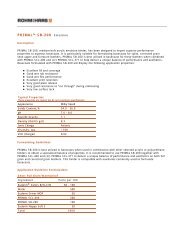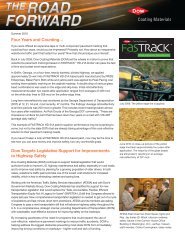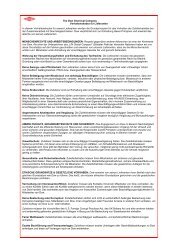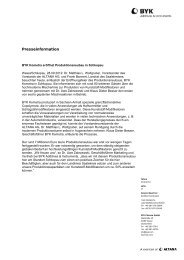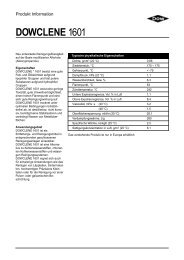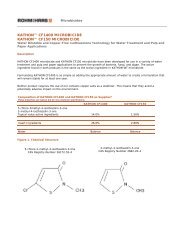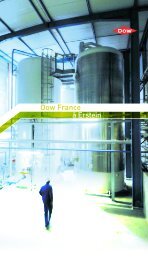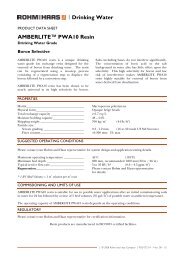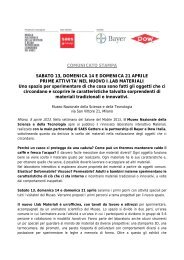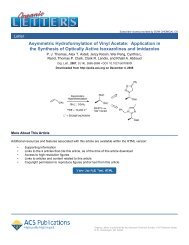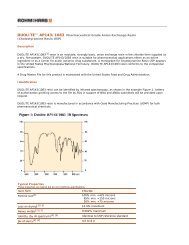GLYCOLS PROPYLENE GLYCOLS - The Dow Chemical Company
GLYCOLS PROPYLENE GLYCOLS - The Dow Chemical Company
GLYCOLS PROPYLENE GLYCOLS - The Dow Chemical Company
You also want an ePaper? Increase the reach of your titles
YUMPU automatically turns print PDFs into web optimized ePapers that Google loves.
<strong>GLYCOLS</strong><br />
<strong>PROPYLENE</strong> <strong>GLYCOLS</strong><br />
Alton E. Martin - Frank H. Murphy<br />
DOW CHEMICAL COMPANY<br />
117-01785-0306
Vol. 12 <strong>GLYCOLS</strong> (<strong>PROPYLENE</strong>)<br />
<strong>PROPYLENE</strong> <strong>GLYCOLS</strong><br />
<strong>The</strong> propylene glycol family of chemical compounds consists of monopropylene glycol (PG), dipropylene glycol (DPG),<br />
and tripropylene glycol (TPG). <strong>The</strong> proper IUPAC chemical name for PG is 1,2-propanediol and it is listed on the U.S.<br />
EPA Toxic Substances Control Act (TSCA) inventory of chemical substances by its CAS Registry Number, [57-55-6].<br />
<strong>The</strong> IUPAC name and TSCA listing for DPG is oxybispropanol [25265-71-8] and for TPG [(1-methyl-1,2ethanediyl)bis(oxy)]bispropanol<br />
[24800-44-0]. <strong>The</strong>se chemicals are manufactured as coproducts and are used<br />
commercially in a large variety of applications. <strong>The</strong>y are available as highly purified products which meet well-defined<br />
manufacturing and sales specifications. All commercial production is via the hydrolysis of propylene oxide. A fourth<br />
propylene glycol product, trimethylene glycol or 1,3-dihydroxypropane [504-63-2], has been available in commercial<br />
quantities in the past, but is not an important product in the 1990s (1). It was obtained as a by-product in the production<br />
of glycerol by either saponification or fermentation of animal fats (see GLYCEROL).<br />
<strong>The</strong> propylene glycols are clear, viscous, colorless liquids that have very little odor, a slightly bittersweet taste, and<br />
low vapor pressures. <strong>The</strong> most important member of the family is monopropylene glycol, also known as 1,2-propylene<br />
glycol, 1,2-dihydroxypropane, 1,2-propanediol, methylene glycol, and methyl glycol. <strong>The</strong> more common commercial<br />
names are Propylene Glycol Industrial (PGI) and Propylene Glycol USP (PG USP), which designates the grade for<br />
general industrial as opposed to the food and drug grade. All of the glycols are totally miscible with water.<br />
Propylene glycol, when produced according to the U.S. Food and Drug Administration good manufacturing<br />
practice guidelines at a registered facility, meets the requirements of the U.S. Food, Drug, and Cosmetic Act as amended<br />
under Food Additive Regulation CFR Title 21, Parts 170-199. It is listed in the regulation as a direct additive for<br />
specified foods and is classified as generally recognized as safe (GRAS). In addition, it meets the requirements of the<br />
Food <strong>Chemical</strong>s Codex and the specifications of the U.S. Pharmacopeia XXII. Because of its low human toxicity and<br />
desirable formulation properties it has been an important ingredient for years in food, cosmetic, and pharmaceutical<br />
products.<br />
Manufacturing<br />
Wurtz (2) first prepared propylene glycol in 1859 by hydrolysis of propylene glycol diacetate, and it was commercialized<br />
in 1931 by Carbide and Carbon <strong>Chemical</strong>s Corp. (3). This first commercial production used the chlorohydrin process to<br />
make propylene oxide, which was subsequently hydrolyzed to the glycol. In the mid1930s Du Pont Co. operated a high<br />
pressure coconut oil hydrogenation plant which yielded propylene glycol as a by-product. Propylene glycol was gaining<br />
acceptance as a substitute for glycerol in pharmaceuticals, and shortages during World War II led to new production<br />
facilities by <strong>Dow</strong> <strong>Chemical</strong> Co. in 1942 and Wyandotte <strong>Chemical</strong> Corp. in 1948.<br />
All commercial production of propylene glycol is by high pressure, high temperature, noncatalytic hydrolysis of<br />
propylene oxide (qv). A large excess of water is used in the conversion of propylene oxide to a mixture of mono-, di-,<br />
and tripropylene glycols. Typical product distribution is 90% PG and 10% coproducts. Hydration reactor conditions are<br />
120-190°C at pressures up to 2170 kPa. After the hydration reaction is completed, excess water is removed in multieffect<br />
evaporators and drying towers, and the glycols are purified by high vacuum distillation.<br />
Propylene oxide [75-56-9] is manufactured by either the chlorohydrin process or the peroxidation (coproduct)<br />
process. In the chlorohydrin process, chlorine, propylene, and water are combined to make propylene chlorohydrin,<br />
which then reacts with inorganic base to yield the oxide. <strong>The</strong> peroxidation process converts either isobutane or<br />
ethylbenzene directly to an alkyl hydroperoxide which then reacts with propylene to make propylene oxide, and t-butyl<br />
alcohol or methylbenzyl alcohol, respectively. Table 1 lists producers of propylene glycols in the United States.<br />
Table 2 shows the production, sales, and value for the glycols in the United States in 1990. Production of<br />
monopropylene glycol peaked in 1988 at 404,000 t. Imports have been minimal except for the mid-1980s when 25,600 t<br />
were imported in 1984. In the period 1986-1989 U.S. exports averaged about 75,000 t per year.<br />
Table 1. U.S. Producers of Propylene Glycols<br />
Producer Location Annual capacity, 10 3 t<br />
Arco a<br />
<strong>Dow</strong> a<br />
<strong>Dow</strong> a<br />
Eastman a<br />
Olin a<br />
Texaco b,c<br />
Bayport, Tex.<br />
163<br />
Freeport, Tex.<br />
113<br />
Plaquemine, La. 68<br />
S. Charleston, W.Va. 36<br />
Brandenburg, Ky. 32<br />
Beaumont, Tex. 68<br />
Total<br />
a<br />
Ref. 4.<br />
480<br />
117-01785-0306
Ref. 5.<br />
c Projected 1994 startup.<br />
Table 2. Production and Sales of Propylene Glycols, 1990 a<br />
Glycol Production, 10 3 t Sales, 10 3 t Average sales, $/kg<br />
Propylene<br />
342.2<br />
258.3<br />
0.94<br />
Dipropylene<br />
35.6<br />
29.4<br />
0.90<br />
Tripropylene<br />
a<br />
Ref. 6.<br />
b<br />
Not reported.<br />
10.4<br />
b<br />
b<br />
Chemistry<br />
Monopropylene glycol (l,2-propanediol) is a difunctional alcohol with both a primary and a secondary hydroxyl.<br />
<strong>Chemical</strong>ly, the presence of the secondary hydroxyl group differentiates propylene glycol from ethylene glycol, which<br />
has two primary hydroxyl groups. Coproducts dipropylene glycol and tripropylene glycol have several possible structural<br />
and stereochemical isomers. Examination of the mechanisms for addition of an alcohol to an oxirane ring under various<br />
reaction conditions explains the distribution of the various isomers in the product mix (7). In the high pressure, high<br />
temperature process for hydrolysis of propylene oxide to propylene glycol and the subsequent formation of dipropylene<br />
and tripropylene glycol, the neutral to slightly acidic conditions dictate a nonspecific opening of the oxirane ring. <strong>The</strong><br />
nonspecific nature of the acid-catalyzed reaction is seen in the approximately 50:50 product distribution for the primary<br />
to secondary alcohol isomers in the dipropylene glycol produced in the process. In the base-catalyzed propoxylation of<br />
an alcohol, for example in poly(propylene glycol) manufacture, attack is at the less substituted position of the oxirane<br />
ring, leading to the preferential formation of the secondary alcohol.<br />
<strong>The</strong> primary and secondary alcohol functionalities have different relativities, as exemplified by the slower reaction<br />
rate for secondary hydroxyls in the formation of esters from acids and alcohols (8). 1,2-Propylene glycol undergoes most<br />
of the typical alcohol reactions, such as reaction with a free acid, acyl halide, or acid anhydride to form an ester; reaction<br />
with alkali metal hydroxide to form metal salts; and reaction with aldehydes or ketones to form acetals and ketals (9,10).<br />
<strong>The</strong> most important commercial application of propylene glycol is in the manufacture of polyesters by reaction with a<br />
dibasic or polybasic acid.<br />
CH3<br />
CH3CHOHCH2OH + HOOCRCOOH HO ( CHCH2OOCRCOO ) nH = n H2O<br />
In the manufacture of unsaturated polyester resins the polyester is synthesized and then diluted with a vinyl reactive<br />
monomer such as styrene (see POLYESTERS, UNSATURATED). A portion of the dibasic acid of the polyester is<br />
maleic or some other vinyl reactive diacid that can be polymerized with the styrene to yield a highly cross-linked, high<br />
performance polymer system. Other esters made with propylene glycol, dipropylene glycol, and tripropylene glycol are<br />
used as emulsifiers in foods, as plasticizers in polymer systems, and as part of acrylate resin systems.<br />
Polyethers are also products of commercial importance. Ethers can be formed by thermal dehydration, as shown<br />
for the formation of dipropylene glycol from propylene glycol. Cyclic ethers can form by elimination of water from dior<br />
tripropylene glycol.<br />
2 CH3CHOHCH2OH CH3CHOHCH2OHCH2CHOHCH3 +H2O<br />
<strong>The</strong> principal product obtained when heating propylene glycol in the presence of aluminum silicate at 200 to 400°C is<br />
the cyclic ether 2,5-dimethyl-l,4-dioxane (11).<br />
<strong>The</strong> synthesis practiced in industry to make the important class of polyethers called polyols or polyglycols is the acid- or<br />
base-catalyzed addition of an epoxide such as propylene oxide to an active hydrogen compound such as a glycol. Any of<br />
the propylene glycols may be used for this purpose. Polyglycols can be tailored to meet rigorous application<br />
specifications for use in polyesters, polyurethanes, or other systems where active hydrogen compounds are needed.<br />
CH3CHOHCH2OH + NaOH CH3CHOHCH2O - Na +<br />
CH3<br />
CH3CHOHCH2O - Na + + CH2CHCH3 CH3CHOHCH2OCH2CHO - Na +<br />
O<br />
117-01785-0306
Oxidation of a glycol can lead to a variety of products. Periodic acid quantitatively cleaves 1,2-glycols to<br />
aldehydes and is used as an analysis method for glycols (12,13). <strong>The</strong> oxidation of propylene glycol over Pd/C modified<br />
with Pb, Bi, or Te forms a mixture of lactic acid, hydroxyacetone, and pyruvic acid (14). Air oxidation of propylene<br />
glycol using an electrolytic crystalline silver catalyst yields pyruvic aldehyde.<br />
Certain bacterial strains convert propylene glycol to pyruvic acid in the presence of thiamine (15); other strains do<br />
the conversion without thiamine (16). Propylene oxide is the principal product of the reaction of propylene glycol over a<br />
cesium impregnated silica gel at 360°C in the presence of methyl ethyl ketone and xylene (17).<br />
Aldehydes and ketones react with glycols to form acetals and ketals which are easily hydrolyzed, making this a<br />
convenien,t method for protecting aldehyde or ketone functionality in organic synthesis. Propylene glycol in the presence<br />
of an acid catalyst reacts with aldehydes and ketones with concurrent removal of water to give 4-methyl-1,3-dioxolanes<br />
(J.8). <strong>The</strong> reaction of chloroacetaldehyde with propylene glycol in the presence of an acid catalyst gives 2-<br />
(chloromethyl)4-methyl-1,3-dioxolane (R = CH2CI; R' == H) (19).<br />
Lactones are prepared from formaldehyde and carbon monoxide by cyclocondensation with propylene glycol in the<br />
presence of a strong acid and a Cu(I) or Ag carbonyl catalyst (20).<br />
Cyclic carbonates are made by treating 1,2diols with dialkyl caronates using an alkyl ammonium and tertiary amine<br />
catalyst. <strong>The</strong> combination of propylene glycol and dimethyl carbonate has been reported to result in a 98% yield of<br />
propylene carbonate (21).<br />
Stereochemical and Structural Isomers<br />
Propylene glycol, dipropylene glycol, and tripropylene glycol all have several isomeric forms. Propylene glycol has one<br />
asymmetric carbon and thus there are two enantiomers: (R)-1,2-propanediol and (S)-1,2-propanediol. 1,3-Propanediol is<br />
a structural isomer. Dipropylene glycol exists in three structural forms and since each structural isomer has two<br />
asymmetric carbons there are four possible stereochemical isomers per structure or a total of twelve isomers. <strong>The</strong>se<br />
twelve consist of four enantiomer pairs and two meso- compounds. Tripropylene glycol has four structural isomers and<br />
each structural isomer has three asymmetric carbons so each structural isomer has eight possible stereochemical isomers<br />
or a total of 32 isomers oftripropylene glycol. Table 3 gives a listing of the IUPAC names, unique structures, and CAS<br />
Registry Numbers for the various isomers of propylene glycol, dipropylene glycol, and tripropylene glycol that have<br />
been reported in the literature.<br />
Physical and <strong>Chemical</strong> Properties<br />
Table 4 lists various physical and chemical properties and constants for the propylene glycols. A comprehensive source<br />
for additional physical and chemical properties is Reference 25.<br />
Consumption and Use<br />
Consumption of propylene glycol follows an erratic pattern in the United States which reflects domestic economic<br />
conditions. Table 5 gives a breakdown by percentage for the principal uses of propylene glycol in the United States.<br />
Propylene Glycol. Propylene glycol is unique among the glycols in that it is safe for humans to take internally.<br />
Propylene glycol intended for human use is designated as USP grade and is commonly found in foods, pharmaceuticals,<br />
cosmetics, and other applications involving possible ingestion or absorption through the skin. <strong>The</strong> U.S. Food and Drug<br />
117-01785-0306
Administration has approved the use of propylene glycol in various food categories, as shown in Table 6.<br />
An industrial grade of propylene glycol is usually specified for other uses. In common with most other glycols,<br />
propylene glycol is odorless and colorless, and has a wide range of solvency for organic materials, besides being<br />
completely water<br />
Table 3. Propylene Glycol Isomers<br />
117-01785-0306
Table 4. Properties of Glycols<br />
Physical properties Propylene Glycol Dipropylene Glycol Tripropylene Glycol<br />
formula<br />
molecular weight<br />
boiling point at 101.3 kPa, a °C<br />
vapor pressure, kP a , a 25°C<br />
density, g/mL<br />
25°C<br />
60°C<br />
freezing point, °C<br />
pour point, °C<br />
viscosity, mPa.s( =cP)<br />
25°C<br />
60°C<br />
surface tension, mN/m(=dyn/cm), 25°C<br />
refractive index at 25°C<br />
specific heat at 25°C, J/(g.K) c<br />
flash point, °C, PMCC d<br />
coefficient of expansion x 10 4, 0-60°C<br />
thermal conductivity at 25°C, W/(m.K)<br />
heat of formation, kJ/mol c<br />
heat of vaporization at 25°C, kJ/mol c<br />
a To convert kPa to mm Hg, multiply by 7.5.<br />
b Yaries with isomer distribution.<br />
c To convert J to cal, divide by 4.184.<br />
a PMCC = Penskey-Martens closed cup.<br />
C3H8O2<br />
76.1<br />
187.4<br />
0.017<br />
1.032<br />
1.006<br />
supercools<br />
temperature heat-transfer fluids. For applications involving indirect food contact, heat-transfer fluids formulated with the<br />
USP grade product are preferred, since there could be inadvertent contact with a food product. <strong>The</strong>se fluids are<br />
commonly used in the brewing and dairy industries as well as in refrigerated display cases in retail grocery stores.<br />
Propylene glycol is also an effective humectant, preservative, and stabilizer and is found in such diverse<br />
applications as semimoist pet food, bakery goods, food flavorings, salad dressings, and shave creams. Humectancy, or<br />
the capability of retaining moisture in a product, is a result of the vapor-liquid equilibria of the glycol-water system and<br />
can be estimated from tables provided by suppliers (27).<br />
<strong>The</strong> industrial grade of propylene glycol is an important intermediate in the production of alkyd resins for paints<br />
and varnishes. It is the preferred glycol for manufacturing high performance, unsaturated polyester resins for many uses,<br />
eg, reinforced plastic laminates for marine construction, gel coats, sheet molding compounds (SMC), and synthetic<br />
marble castings. It is also used as a solvent and plasticizer in printing inks, as a preservative in floral arrangements, and<br />
as a stabilizer in hydraulic fluids. Heat-transfer fluids used in commercial and industrial building heating and cooling<br />
systems, chemical plants, stationary engines, and solar heat recovery can be formulated with the industrial grade of<br />
propylene glycol. More recently, propylene glycol-based coolants for automobiles and heavy duty diesel engine trucks<br />
have been introduced which compete with traditional ethylene glycol-based products (28,29). <strong>The</strong> newly published<br />
ASTM standard D5216 specifies aqueous propylene glycol-based engine coolants for automobile and light-duty truck<br />
service. All heat-transfer applications require corrosion inhibitor additives and are designed for specific operating<br />
temperature ranges and types of materials of construction. Operation at low temperature without freezing and at high<br />
temperature without excessive pressure are the principal features of these systems.<br />
Due in large part to its lower toxicity and the concomitant lesser concern about its environmental impact,<br />
propylene glycol use in the air transportation industry as an airplane and runway deicing agent has grown substantially in<br />
recent years (see ANTIFREEZES AND DEICING FLUIDS). Other glycols, such as ethylene glycol, have historically<br />
been used in this industry.<br />
Dipropylene Glycol. Dipropylene glycol is similar to the other glycols in general properties, and its fields of use<br />
are comparable. However, its greater solvency for certain materials and higher viscosity make it of interest in certain<br />
applications for which the other glycols are not as well suited. <strong>The</strong> greater solvency of dipropylene glycol for castor oil<br />
indicates its usefulness as a component of hydraulic brake fluid formulations; its affinity for certain other oils has<br />
likewise led to its use in cutting oils, textile lubricants, and industrial soaps. It is also used as a reactive intermediate in<br />
manufacturing polyester resins, plasticizers, and urethanes. Fragrance or low odor grades of dipropylene glycol are<br />
established standard base formulating solvents in the fragrance industry and for some personal care products such as<br />
deodorants.<br />
Tripropylene Glycol. Tripropylene glycol is an excellent solvent in many applications where other glycols fail to<br />
give satisfactory results. Its ability to solubilize printing ink resins is especially marked, so much so that it finds its way<br />
into creams designed to remove ink stains from the hands. A combination of water solubility and good solvent power for<br />
many organic compounds plus low volatility and a high boiling point also have led to its use by formulators of textile<br />
soaps and lubricants, cutting oil concentrates, and many similar products. Tripropylene glycol is also used as a reactant<br />
to produce acrylate resins which are useful in radiation-cured coatings, adhesives, and inks. Polyethers used in the<br />
manufacture of urethane rigid foam insulation are made by alkoxylation of tripropylene glycol.<br />
Toxicology<br />
All of the propylene glycols display a low acute oral toxicity in laboratory rats as shown in Table 7 (30). Information for<br />
sucrose is shown for comparison.<br />
Studies in which rats were fed drinking water containing as much as 10% propylene glycol over a period of 140<br />
days (31,32) showed no apparent ill effects. Other investigations have revealed that rats can tolerate up to 4.9%<br />
propylene glycol in the diet for two years without significant effects on growth rate (33). However, minor liver damage<br />
was observed. In a more recent study (34), dogs<br />
Table 7. Acute Oral Toxicity of Propylene Glycols.<br />
Compound Oral rat LD50 g/kg<br />
propylene glycol<br />
20.0<br />
dipropylene glycol<br />
14.9<br />
tripropylene glycol<br />
3.0<br />
sucrose<br />
a<br />
Ref. 30.<br />
29.7<br />
were fed a diet containing 8% propylene glycol for two years and were unaffected, as judged by mortality, body weight<br />
changes, diet utilization, histopathology, organ weights, and blood, urine, and biochemical parameters. Because of its<br />
117-01785-0306
low chronic oral toxicity, propylene glycol is considered safe for use in foods and pharmaceuticals.<br />
Rats showed no adverse effects from 5.0% dipropylene glycol in their drinking water for 77 days, but at a dose of<br />
10.0% in the drinking water, kidney and liver injury and some deaths occurred (35). A sufficient number of studies have<br />
not been carried out on tripropylene glycol to permit conclusions to be drawn regarding its chronic oral toxicity.<br />
Propylene glycols produce a negligible degree of irritation upon eye or skin contact. From tests on New Zealand<br />
white rabbits (36) in 1982 it was concluded that propylene glycol is a slight eye irritant. Other tests conducted both in<br />
vitro and in vivo have shown propylene glycol to be a nonirritant to the eye. Both dipropylene glycol and tripropylene<br />
glycol have been tested for skin and eye irritation in rabbits and have been found to be nonirritating. <strong>The</strong> expert panel of<br />
the Cosmetic Ingredient Review, after conducting a comprehensive safety assessment, has concluded that propylene<br />
glycol may be used in cosmetic products in concentrations up to 50% (37).<br />
Inhalation of the vapors of any of the propylene glycols appears to present no significant hazard in ordinary<br />
applications and this is reflected in the fact that OSHA has not found it necessary to establish a permissible exposure<br />
level in the workplace. However, in 1985 the American Industrial Hygiene Association reviewed human experience and<br />
animal data and established a Workplace Environmental Exposure Level (WEEL) guideline for propylene glycol at 50<br />
ppm total vapor and aerosol averaged over an eight-hour period. Although not legally binding, the WEEL guidelines<br />
have been adopted by industry as good industrial hygiene practice. Limited data indicate that breathing mists of di- and<br />
tripropylene glycol may be harmful. Prolonged inhalations of saturated vapors of propylene glycol have produced no ill<br />
effects in animals, but such concentrations would likely be irritating to the upper respiratory tract and possibly the eyes<br />
of humans. Only limited work has been done on the vapor toxicity of the other glycols; however, because of their very<br />
low vapor pressures and low systemic toxicities, it is unlikely that injury would occur as a result of limited vapor<br />
inhalation.<br />
Environmental Considerations<br />
<strong>The</strong> propylene glycols vary in biodegradability, as shown in Table 8. <strong>The</strong> tests involved were conducted with standard<br />
municipal inoculum, and other studies (31) have shown that biodegradability can be greatly enhanced when using an<br />
acclimated bacteria. For example, tripropylene glycol has shown 66% of theoretical oxygen demand at 20 days with an<br />
industrial seed. Thus it is expected that all of the propylene glycols will exhibit moderate to high biodegradability in a<br />
natural environment.<br />
All of the propylene glycols are considered to be practically nontoxic to fish on an acute basis (LC50 > 100 mg/L)<br />
and practically nontoxic to aquatic invertebrates, also on an acute basis. Acute marine toxicology testing (38) on<br />
propylene<br />
Table 8. Biodegradation of Propylene Glycols With Standard Municipal Inoculum<br />
Glycol <strong>The</strong>oretical O2 demand 5-day O2 demand 10-Day O2 demand 20-Day O2 demand<br />
PG<br />
1.68<br />
1.16<br />
1.18<br />
1.45<br />
DPG<br />
1.91<br />
a<br />
.014<br />
0.71<br />
TPG<br />
a<br />
Data not available<br />
1.38<br />
a<br />
a<br />
a<br />
glycol showed that the 96-h LC50 for fathead minnows was 54,900 mg/L and the 48-h LC50 for Daphnia magna was<br />
34,400 mg/L. A 24-h NOEL of 50,000 mg/L was also observed for fingerling trout. Similar results were observed for<br />
guppies and rainbow trout (39).<br />
BIBLIOGRAPHY<br />
"Glycols"in ECT 1st ed., Vol. 7, pp. 238-263, by C. P. McClelland and P. R. Rector, Carbide and Carbon <strong>Chemical</strong>s Co.,<br />
a Division of Union Carbide and Carbon Corp.; "Ethylene Glycol, Propylene Glycol, and <strong>The</strong>ir Derivatives" under<br />
"Glycols" in ECT 2nd ed., Vol. 10, pp. 638-660, by P. H. Miller, Union Carbide Corp.; "Ethylene Glycol and Propylene<br />
Glycol" under "Glycols" in ECT 3rd ed., Vol. 11, pp. 933-956, by E. S. Brown, C. F. Hauser, B. C. Ream, and R. V.<br />
Berthold, Union Carbide Corp.<br />
1. J. W. Lawrie, Glycerol and the Glycols, Monograph Series, American <strong>Chemical</strong> Society, 1928, New York, p. 388.<br />
2. A. Wurtz, Ann. Chim. Phys. 55(3), 438 (1859).<br />
3. I. MeHan, Polyhydric Alcohols, Spartan Books, Washington, D.C., 1962, p. 46.<br />
4. Chern. Mark. Rep., 45 (Jan. 4,1993).<br />
5. D. J. Caney, Chern. Mark. Rep., 13 (July 20,1992).<br />
6. Synthetic Organic <strong>Chemical</strong>s, United States Production and Sales, United States International Trade Commission,<br />
Washington, D.C., 1990.<br />
7. R. E. Parker and N. S. Isaacs, Chern. Rev. 59, 737 (1959).<br />
117-01785-0306
8. G. Reginato, A. Ricci, S. Roelens, and S. Scapecchi, J. Org. Chern. 55, 5132 (1990).<br />
9. J. A. Monick, Alcohols-<strong>The</strong>ir Chemistry, Properties, and Manufacture, Reinhold Publishing Corp., New York, 1968.<br />
10. G. O. Curme and F. Johnston, Glycols, Reinhold Publishing Corp., New York, 1953.<br />
11. E. Swistak, Compt. Rend. 240, 1544 (1955).<br />
12. S. Siggia, Quantitative Organic Analysis via Functional Groups, John Wiley & Sons, Inc., New York, 1949, p. 8.<br />
13. Ref. 10, p. 329.<br />
14. T. Tsujino, S. Ohigashi, S. Sugiyama, K. Kawashiro, and H. Hayashi, J. Mol. Catal. 71(1), 25-35, 1992.<br />
15. Y. Izumi, Y. Matsumura, Y. Tani, and H. Yamada, Agric. BioI. Chern. 46(11), 2673-2679 (1982).<br />
16. T. Shigeno and T. Nakahara, Biotechnol. Lett. 13(11), 821-826 (1991).<br />
17. Eur. Pat. Appl. EP 145447 (June 19, 1985), J. Y. Ryn (to Exxon Research and Engineering Co.).<br />
18. T. H. Chan, M. A. Brook, and T. Chaly, Synthesis, 203 (1983).<br />
19. Eur. Pat. 456157 Al (Nov. 13, 1991), M. Ishizuka and T. Wakasugi (to Kureha <strong>Chemical</strong> Industry Co., Ltd., Japan).<br />
20. U.S. Pat. 4,990,629 (Feb. 5, 1991), Y. Souma (to Agency of Industrial Science and Technology Japan).<br />
21. U.S. Pat. 5,091,543 (Feb. 25, 1992), R. A. Grey (to Arco <strong>Chemical</strong> Technology, Inc.).<br />
22. A. R. Sexton and E. C. Britton, J. Am. Chem. Soc. 75, 4357 (1953).<br />
23. A Guide To Glycols, Brochure 117-00991-92HYC, <strong>The</strong> <strong>Dow</strong> <strong>Chemical</strong> Co., <strong>Chemical</strong>s and Metals Department,<br />
Midland, Mich., 1992.<br />
24. R. C. West and J. G. Grasselli, Handbook of Data on Organic Compounds, 2nd ed., Vol. VI, CRC Press Inc., Boca<br />
Raton, Fla., 1989.<br />
25. Physical and <strong>The</strong>rmodynamic Properties of Pure <strong>Chemical</strong>s, American Institute of <strong>Chemical</strong> Engineers, New York,<br />
1991.<br />
26. M. Burr and L. Tice, J. Am. Pharm. Assoc. XLVI(4), 217 (1957).<br />
27. A Guide to Glycols, <strong>The</strong> <strong>Dow</strong> <strong>Chemical</strong> Co., Midland, Mich., 1992.<br />
28. G. E. Coughenour and L. K Hwang, Paper 930584, Society of Automotive Engineers, Inc., Warrendale, Pa., 1993.<br />
29. W. J. Kilmartin and D. C. Dehm, Paper 930588, Society of Automotive Engineers, Inc., Warrendale, Pa., 1993.<br />
30. R. J. Lewis, Sr., Dangerous Properties of Industrial Materials, 8th ed., Van Nostrand Reinhold, New York, 1992.<br />
31. M. A. Seidenfeld and P. J. Hanzlik, J. Pharmacol. Exp. <strong>The</strong>rap. 44, 109 (1932).<br />
32. J. H. Weatherby and H. G. Haag, J. Am. Pharm. Ass. 27, 446 (1938).<br />
33. H. J. Morris and co-workers, J. Pharmacol. Exp. <strong>The</strong>rap. 74, 266 (1942).<br />
34. C. S. Weil and co-workers, Food Cosmet. Toxicol. 9,479 (1971).<br />
35. H. D. Keston, N. G. Mulinos, and L. Pomerantz, Arch. Pathol. 27,447 (1939).<br />
36. J. P. Guillot, and co-workers, Food Chem. Toxicol. 20(5), 573-582 (1982).<br />
37. Tentative Report of the Safety Assessment of Propylene Glycol, Cosmetic Ingredient Review, <strong>The</strong> Cosmetic, Toiletry,<br />
and Fragrance Association, Washington, D.C., 1992.<br />
3B. K Verschueren, Handbook of Environmental Data, 2nd ed., Van Nostrand Reinhold Co., New York, 1983.<br />
39. F. L. Mayer, and M. R. Ellersieck, Manual of Acute Toxicity: Interpretation & DB, FWS, Resource Publ. 160, U.S.<br />
Department of the Interior, Washington, D.C., 1986.<br />
ALTON E. MARTIN<br />
FRANK H. MURPHY<br />
<strong>The</strong> <strong>Dow</strong> <strong>Chemical</strong> <strong>Company</strong><br />
117-01785-0306



